ENDOLITE
Prosthetics
The ESK+
|
|
|
|
|
| The
ESK+ is for people who want to get involvedwith life. Family barbecues,
afternoon shopping, fishing with grandchildren, a city stroll. All
comfortably undertaken with the subtle support and gait speed
management provided by the ESK+. |
We
believe that the knee should perform for each individual so you don’t
have to moderate your gait to suit the knee. The selection of
functional options ensures optimal performance from each limb. |
| |
|
- Hydraulic and pneumatic swing phase control
- Microprocessor swing control
- Weight activated mechanical stance control
- Optional knee lock
- Adjustable StanceflexTM (see article)
|
|

 |
The
design has been improved to enhance the progressive release function.
This unique feature means that the stabilisation gradually
comes
off leading smoothly and securely into swing phase. Combined with the
improved durability features and range of sensativity this results in a
confident and comfortable walking pattern.
The ESK+ with Manual Knee Lock has the bonus feature of an optional
lock for those times when total security is preferred. Beneficial for
people who are beginning rehabilitation and who need a little extra
confidence from time to time. Ideal for individuals who stand for
protracted periods.
|
|
|
| |
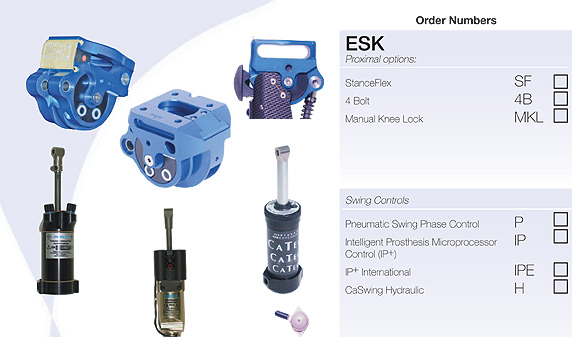
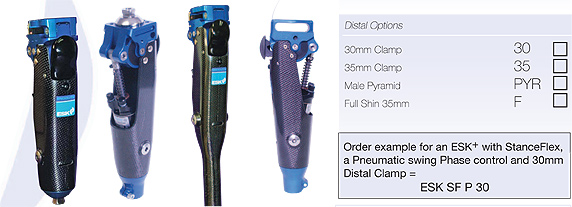
|
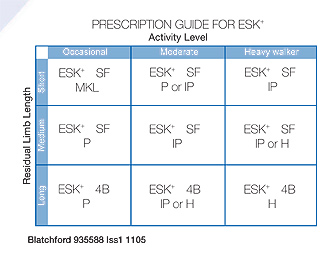 |
Thigh release:
MKL Lock actuator
MKL Hip cable converstion kit
Socket adaptors:
Full alignment pyramid kit std
5mm lengthening
10mm lengthening
Full alignment kit std
10mm shortening
5mm shortening
5mm lengthening
10mm lengthening
4 bolt Pyramid socket adaptor
4 bolt rotating sliding pyramid
4 bolt Short knee alignment kit
IP+ Programmer with pouch:
418Mhz UK only
4333Mhz Outside UK |
239640
239023
189127
189227
189327
189806
189805
189808
189809
189807
P409049 large
P409050 small
239017
239019
019142
019142E
|
|
 |
Introduction
Investigations into the constituent elements of human gait have provided
some interesting thinking on the role of stance flexion. Saunders et al. (1953)
proposed the theory that stance-phase knee flexion along with pelvic
rotation and obliquity reduces BCOM displacement and therefore
conserves energy for normal subjects. Childress & Gard (1997)
questioned the role of stance flexion in BCOM displacement because of
phasing discrepancies and in a follow up paper: Gard et al. (1997),
posited that stance-phase knee flexion plays a critical role in
providing shock absorption since load is rapidly transferred from the
trailing limb to the leading limb during non-amputee gait.
|
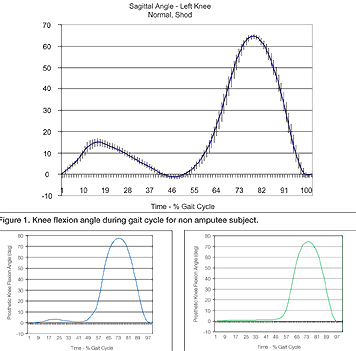 |
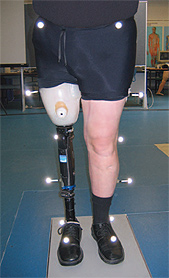 |
Methodology
Data was collected at the University of Surrey by Chittoor (2005). 2
trans-femoral amputees were fitted with various knees which claimed
stance flexion including an Endolite ESK, a single axis brake knee, two
linkage knees and a prototype knee with dual stance flexion. 3
non-amputee volunteers were used to benchmark the data. Passive
retro-reflective markers were used for kinematic data collection. Force
plate kinetic data provided magnitude and timing of heel strike
transients and peak ground reaction forces. Data analysis provided the
timing and magnitude of peak stance flexion angles.
Conclusion
It was noted that the knee with dual flexion devices, proximal and distal to the
pivot, showed an earlier onset: enhancing the stance flexion. Different Prosthetic |
knees
provided stance flexion angles of various magnitudes, from 0 to 7
degrees, as the BCOM was ascending: and therefore, may suggest reduced
vertical displacement. The knee angle curves representing stance
flexion were not consistent with those of the non-amputee knees; indeed
one linkage knee retained a SF angle to the end of stance phase.
Since the SF angle acts to shorten the effective length of the
prosthesis then it is possible that delayed stance flexion may impact
on the sound side swing through. Anecdotal evidence from amputees
taking part in the test suggested that those knees which demonstrated a
stance- flexion angle provided shock absorption and contributed to
comfort. Further work is therefore planned to establish the
contribution of Stance-flexion to walking comfort and to develop a set
of guidelines for the most effective design. |
| |
|
|
1.
Gard S, Childress D, The Effect of Stance-Phase Knee Flexion on the
Vertical Displacement of the Trunk during Normal Walking. American
Society of Biomechanics, 21st Annual Mtg. 09/1997.
2. Saunders JB,
Inman M, Eberhart HD. The major determinants in normal and pathological
gait. Journal Bone Joint Surgery 1953;35-A:543-58.
3- Chittoor S MSc. Thesis University of Surrey 2005
BCOM: Body Centre of Mass |
|
|

